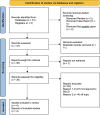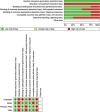Accuracy of temporomandibular disorders diagnosis evaluated through the diagnostic criteria for temporomandibular disorder (DC/TDM) Axis II compared to the Axis I evaluations: a systematic review and meta-analysis
- PMID: 38431574
- PMCID: PMC10909276
- DOI: 10.1186/s12903-024-03983-7
Accuracy of temporomandibular disorders diagnosis evaluated through the diagnostic criteria for temporomandibular disorder (DC/TDM) Axis II compared to the Axis I evaluations: a systematic review and meta-analysis
Abstract
Background: The temporomandibular joint (TMJ) is a complex joint that facilitates mandibular movements during speech, chewing, and swallowing activities. The Axis I evaluation of the DC/TMD focuses on assessing physical diagnoses related to TMDs. It includes an assessment of pain and functional limitations, such as jaw opening range, joint sounds, and joint tenderness. The Axis II evaluation of the DC/TMD provides information on the patient's psychological status and quality of life. This Systematic Review with Meta-Analysis aimed to evaluate the accuracy of Temporomandibular Disorders diagnosis considered through the Diagnostic Criteria for Temporomandibular Disorder (DC/TDM) axis II compared to the Axis I evaluations.
Methods: A search was made in PubMed, Web of Science and Lilacs for articles published from the inception until 20 January 2023. We applied the Population, Exposure, Comparator, and Outcomes (PECO) model [1] to assess document eligibility. Only studies that evaluated patients by DC/TMD Axis I and Axis II were considered. Review Manager version 5.2.8 (Cochrane Collaboration) was used for the pooled analysis. We measured the odds ratio (OR) between the two groups (Axis I and Axis II).
Results: Fifty-one articles were selected because of the search. Four papers were excluded before the screening: 2 pieces were not in English, and two were reviewed. The remaining 47 articles were selected for the title and abstract screening to evaluate whether they met the PECO criteria. Among these, four papers were established; the overall effect showed that there was no difference in TMD diagnosis between Axis I and Axis II (RR 1.17; 95% CI: 0.80- 1.71; Z:0.82; P = .41), suggesting that there is no difference between Axis I and Axis II.
Conclusion: In conclusion, DC/TMD is an effective tool for the diagnosis of TMD. It improves the accuracy of TMD diagnosis, allows for the classification of subtypes, and assesses psychosocial factors that may impact the development or maintenance of TMD symptoms.
Keywords: Axis I; Axis II; DC/TMD; Temporomandibular disorders.
© 2024. The Author(s).
Conflict of interest statement
The authors declare no competing interests.
Figures



Similar articles
-
Diagnostic Criteria for Temporomandibular Disorders (DC/TMD) for Clinical and Research Applications: recommendations of the International RDC/TMD Consortium Network* and Orofacial Pain Special Interest Group†.J Oral Facial Pain Headache. 2014 Winter;28(1):6-27. doi: 10.11607/jop.1151. J Oral Facial Pain Headache. 2014. PMID: 24482784 Free PMC article.
-
Executive summary of the Diagnostic Criteria for Temporomandibular Disorders for clinical and research applications.J Am Dent Assoc. 2016 Jun;147(6):438-45. doi: 10.1016/j.adaj.2016.01.007. Epub 2016 Feb 26. J Am Dent Assoc. 2016. PMID: 26922248 Free PMC article.
-
Oral health-related quality of life in patients with temporomandibular disorders.J Orofac Pain. 2007 Winter;21(1):46-54. J Orofac Pain. 2007. PMID: 17312641
-
Association between chewing dysfunctions and temporomandibular disorders: A systematic review.J Oral Rehabil. 2018 Oct;45(10):819-835. doi: 10.1111/joor.12681. Epub 2018 Jul 4. J Oral Rehabil. 2018. PMID: 29908034
-
Quality of life in young and middle age adult temporomandibular disorders patients and asymptomatic subjects: a systematic review and meta-analysis.Health Qual Life Outcomes. 2021 Mar 10;19(1):83. doi: 10.1186/s12955-021-01727-7. Health Qual Life Outcomes. 2021. PMID: 33691709 Free PMC article.
Cited by
-
Relationships between personality factors and DC/TMD Axis II scores of psychosocial impairment among patients with pain related temporomandibular disorders.Sci Rep. 2024 Nov 6;14(1):26869. doi: 10.1038/s41598-024-78216-6. Sci Rep. 2024. PMID: 39501058 Free PMC article.
-
Analysis of the Effect of Exams on Perceived Stress and Temporomandibular Joint Status in Physiotherapy Students: A Pilot Study.Medicina (Kaunas). 2024 Jun 7;60(6):952. doi: 10.3390/medicina60060952. Medicina (Kaunas). 2024. PMID: 38929569 Free PMC article.
-
[Development and validation of a clinical automatic diagnosis system based on diagnostic criteria for temporomandibular disorders].Beijing Da Xue Xue Bao Yi Xue Ban. 2025 Feb 18;57(1):192-201. doi: 10.19723/j.issn.1671-167X.2025.01.029. Beijing Da Xue Xue Bao Yi Xue Ban. 2025. PMID: 39856527 Free PMC article. Chinese.
-
Defining Effect Size Standards in Temporomandibular Joint and Masticatory Muscle Research.Med Sci Monit. 2025 May 1;31:e948365. doi: 10.12659/MSM.948365. Med Sci Monit. 2025. PMID: 40308008 Free PMC article.
References
-
- Dimitroulis G. Management of temporomandibular joint disorders: a surgeon’s perspective. Aust Dent J. 2018;63(Suppl 1):79–90. - PubMed
-
- Kalladka M, Young A, Thomas D, Heir GM, Quek SYP, Khan J. The relation of temporomandibular disorders and dental occlusion: a narrative review. Quintessence Int. 2022;53(5):450–9. - PubMed
-
- Easterbrook S, Keys J, Talsma J, Pierce-Talsma S. Osteopathic manipulative treatment for Temporomandibular disorders. J Am Osteopath Assoc. 2019;119(6):e29–30. - PubMed
-
- Choi S, Kang YS, Yeo ISL. Influence of Implant–Abutment Connection Biomechanics on Biological Response: A Literature Review on Interfaces between Implants and Abutments of Titanium and Zirconia. Prosthesis [Internet]. 2023;5(2):527–38. Available from: https://www.scopus.com/inward/record.uri?eid=2-s2.0-85163744250amp;doi=1....
Publication types
MeSH terms
LinkOut - more resources
Full Text Sources
Medical
Miscellaneous

